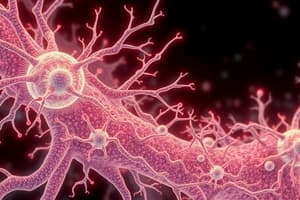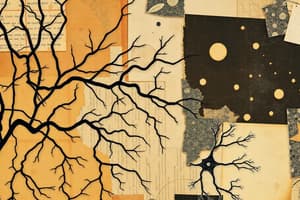Podcast
Questions and Answers
Which of the following is NOT a characteristic of nervous tissue?
Which of the following is NOT a characteristic of nervous tissue?
- Extensive integrated communication network
- Contains a large extracellular matrix (correct)
- Derived from neural ectoderm
- Cells chemically linked to form circuits
What embryonic layer gives rise to nervous tissue?
What embryonic layer gives rise to nervous tissue?
Ectoderm
Which of the following is NOT a function of nervous tissue?
Which of the following is NOT a function of nervous tissue?
- Senses changes in environment
- Stores nutrients (correct)
- Transmits stimuli
- Generates behavior patterns
What are the three categories of neurons?
What are the three categories of neurons?
What characteristics do neurons have?
What characteristics do neurons have?
Name three components in the cell body of a nerve cell.
Name three components in the cell body of a nerve cell.
The diameter of an axon can change.
The diameter of an axon can change.
In which direction do action potentials travel?
In which direction do action potentials travel?
How many axons and dendrites does a typical neuron have?
How many axons and dendrites does a typical neuron have?
What are conducted down dendrites toward the cell body of a neuron?
What are conducted down dendrites toward the cell body of a neuron?
What is the function of bipolar neurons?
What is the function of bipolar neurons?
Where are bipolar neurons located?
Where are bipolar neurons located?
What is the function of pseudounipolar neurons?
What is the function of pseudounipolar neurons?
Which of the following are considered general senses?
Which of the following are considered general senses?
The peripheral process of a pseudounipolar neuron conducts toward the which part?
The peripheral process of a pseudounipolar neuron conducts toward the which part?
The central process of a pseudounipolar neuron conducts toward what?
The central process of a pseudounipolar neuron conducts toward what?
Where are the cell bodies of pseudounipolar neurons located?
Where are the cell bodies of pseudounipolar neurons located?
What is the function of multipolar neurons?
What is the function of multipolar neurons?
Where are multipolar neurons located?
Where are multipolar neurons located?
Which type of neuron is the most numerous?
Which type of neuron is the most numerous?
What are the contact points or effectors for synapses?
What are the contact points or effectors for synapses?
What do synapses help maintain?
What do synapses help maintain?
What are the two types of synapses, and which is more common?
What are the two types of synapses, and which is more common?
How are nerve impulses conducted by electrical synapses?
How are nerve impulses conducted by electrical synapses?
How are nerve impulses conducted by chemical synapses?
How are nerve impulses conducted by chemical synapses?
What are the three sites of synapse on a neuron?
What are the three sites of synapse on a neuron?
Which cells support the central nervous system?
Which cells support the central nervous system?
Neuroglia are more numerous than neurons.
Neuroglia are more numerous than neurons.
Why are glial cells more likely to become cancerous than neurons?
Why are glial cells more likely to become cancerous than neurons?
What are the four types of glial cells?
What are the four types of glial cells?
Which glial cells are the most numerous?
Which glial cells are the most numerous?
What is the difference between fibrous and protoplasmic astrocytes in terms of processes?
What is the difference between fibrous and protoplasmic astrocytes in terms of processes?
Where are fibrous astrocytes and protoplasmic astrocytes located?
Where are fibrous astrocytes and protoplasmic astrocytes located?
What are the functions of astrocytes?
What are the functions of astrocytes?
Flashcards are hidden until you start studying
Study Notes
Characteristics of Nervous Tissue
- Originates from the neural ectoderm.
- Comprised mostly of cells with minimal extracellular matrix.
- Cells are chemically interconnected, forming complex circuits.
- Functions as a vast, integrated communication network.
- Contains excitable neurons capable of conducting stimuli.
Embryonic Origin
- Nervous tissue is derived from the ectoderm layer.
Functions of Nervous Tissue
- Detects environmental changes.
- Transmits stimuli to effectors for responses.
- Stabilizes internal conditions or produces behavioral patterns.
Types of Neurons
- Motor Neurons: Transmit impulses from the central nervous system (CNS) to effectors.
- Sensory Neurons: Carry signals from sensory receptors to the CNS.
- Interneurons: Facilitate communication between different neurons.
Characteristics of Neurons
- Neurons are irritable, conductive, and post-mitotic (do not divide).
Components of Nerve Cell Body
- Prominent nucleolus indicates active synthesis.
- Rich in rough endoplasmic reticulum for protein production.
- Contains polyribosomes, known as Nissl substance, for ribonucleic acid synthesis.
Axon Characteristics
- The diameter of an axon remains constant and does not change.
- Action potentials travel away from the neuron’s cell body.
Neuron Structure
- Each neuron has one axon and a variable number of dendrites (pseudounipolar, bipolar, multipolar).
- Graded potentials are conducted down dendrites toward the cell body.
Bipolar Neurons
- Serve special sensory functions.
- Found in the cochlear and vestibular ganglia, olfactory mucosa, and retina.
Pseudounipolar Neurons
- Function in general sensory processing.
- Convey signals related to pain, temperature, touch, and proprioception.
- Peripheral process leads to the cell body, while the central process carries signals to the CNS.
Multipolar Neurons
- Primarily involved in motor functions.
- Located in key brain regions such as the cerebrum, spinal cord (lateral/ventral horns), and cerebellum.
Neuron Distribution
- Multipolar motor neurons are the most abundant type.
Synapses and Impulse Transmission
- Synapses contact muscles, glands, and other neurons.
- They ensure unidirectional transmission of nerve impulses.
Types of Synapses
- Electrical Synapses: Utilize gap junctions for direct electrical current flow.
- Chemical Synapses: More common, rely on neurotransmitter release from synaptic vesicles.
Synapse Sites on Neuron
- Dendrite (axodendritic), soma (axosomatic), axon (axoaxonic) as potential connection sites.
Supporting Cells in CNS
- Neuroglia (glial cells) are present in greater numbers than neurons.
- Glial cells are prone to cancer due to their ability to undergo mitosis, unlike neurons.
Types and Functions of Glial Cells
- Astrocytes: Most numerous, support neuron function, maintain the microenvironment, and help form the blood-brain barrier.
- Oligodendrocytes: Provide insulation to axons in the CNS.
- Microglia: Act as immune defenders in the CNS.
- Ependymal Cells: Line the cavities of the CNS and help circulate cerebrospinal fluid.
Astrocyte Characteristics
- Fibrous astrocytes: Fewer long processes and located in white matter of the CNS.
- Protoplasmic astrocytes: Numerous short processes found in gray matter of the CNS.
Functions of Astrocytes
- Anchor neurons to capillaries.
- Maintain environment around neurons.
- Form scar tissue in damaged areas.
- Contribute to the blood-brain barrier’s integrity.
Studying That Suits You
Use AI to generate personalized quizzes and flashcards to suit your learning preferences.




